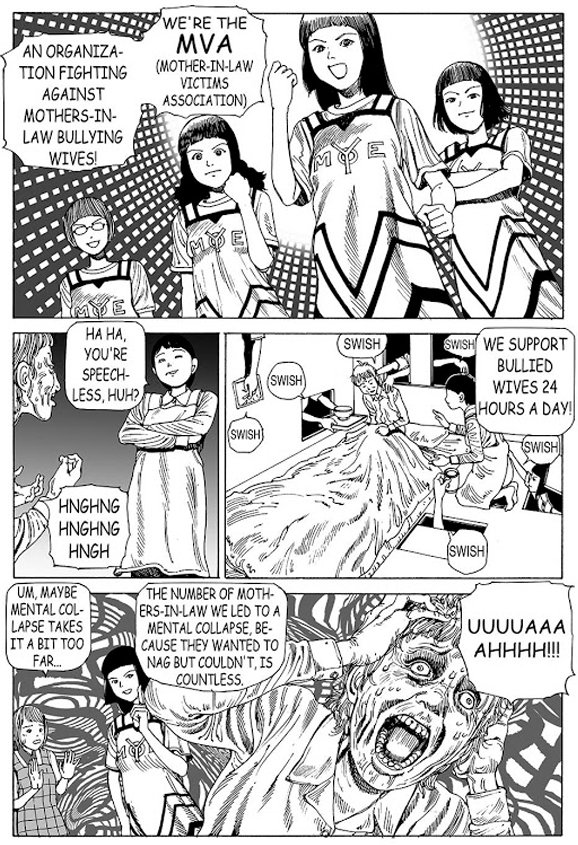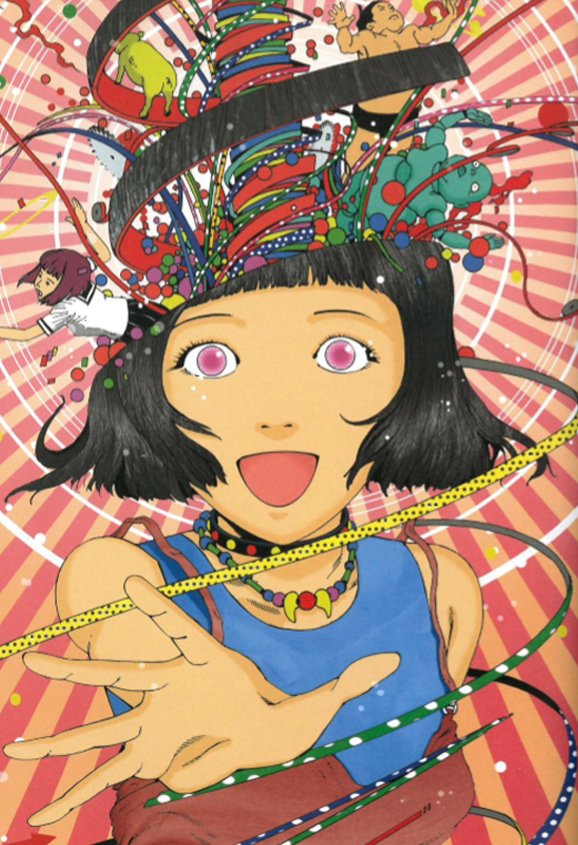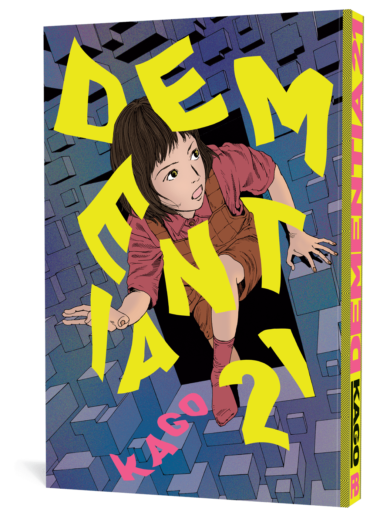Dementia 21 Review
Typically I am not one for horror, not just in anime or manga, but the genre as a whole. An overactive imagination and a jump reflex like a starting pistol has often meant I get little enjoyment from horror media. With this in mind, I was a little wary when looking into reviewing Shintaro Kago’s, Dementia 21. Understandable, considering titles of his previous work being; Black Theatre: Grandma Smells Like a Corpse and The Book of Killing and Killing: Thirteen Horrible Sufferings in Great Edo. However, Kago’s art was brimming with character and stylized in a way very different from traditional manga. With this in mind, I decided to give it a try, and I am very happy I did. Simply labeling Kago’s work as “fashionable paranoia” (a label often given to his brand of storytelling) does not really describe Dementia 21 accurately. What he has created is a series of stories that are equal parts disturbing and satire. It’s a series of dark comedy stories with deeper themes behind them, and while not all of them hit the mark, there is plenty of the unique, absurd and creepy to hold your interest.

We follow the eager young home health aide, Yukie Sakai, who is determined to do whatever she can to help the elderly under her care. This becomes much more challenging after the meddling of a jealous co-worker at her agency, Green Net. This leads to Yukie being made to take on their most bizarre, testing, and often life-threatening roles. Each chapter is a story in which Yuki has to face a different trial in her role as a carer, on her mission to earn valuable high scores from elderly clients (to which her ability at Green Net is graded) and earn back her rightful place at the top of her agency. This quest leads to increasingly surreal jobs where her life, those under her care, world peace and even the fate of Planet Earth in an intergalactic war, all hang in the balance.

Image credit: Fantagraphics Books
On the surface Yukie is hard working, determined, and rather naive. In the context she is the perfect vehicle to drive the reader through the plot. As she is thrown into each absurd situation, she reacts with the horror and confusion that anyone would in her position, and the way that Kago’s art captures these reactions is just excellent. Yukie’s expressive responses can range from simple comedic reactions to the more detailed strained expressions of horror. In the face of these continually bizarre situations that she is confronted with, her determination usually leads to her finding an equally ridiculous solution to the problem. Helping Kaiju-sized elderly monsters find common ground, solving an aggressive wrinkle epidemic or creating world peace through a ridiculously high level of… well, care. She is taken back from the absurd circumstances she is put in, with the same shock as the reader, then goes head-first into them to solve the problem in equally absurd fashion. It lends itself to the humorous tone of Dementia 21 while also giving us an endearing leading woman.
If you look deeper, however, there is a darker side to her character. At the end of the day, she is doing this for points and sometimes her actions are not always in the client’s best interest. She is driven, which is admirable, but sometimes this drive can blur the line between her and the less savoury characters in the story. Though it does make her a far more interesting character, and provides additional depth to both her and the themes on society and behaviour.

Image credit: Fantagraphics Books
Shintaro Kago states in a short Q & A at the back of the book that he prefers his work to speak for itself, rather than have to explain the many themes and meanings behind the stories. Though there seem to be many due to the eclectic nature of the stories, other than the obvious, such as society’s views and treatment of the elderly and old age in general. There are many broader themes on society as a whole, depending on how the reader interprets the stories.
For those unfamiliar, Shintaro Kago’s work has many elements of what is called; Ero Guro Nansensu (roughly a Japanese combination of English abbreviated words: Erotic, Grotesque, Nonsense): a Japanese movement in art and literature, spanning back as early as the 1930s, where shocking images are used in reaction to socio-political themes. Often these stories involve a person who is impacted by an event or aspect of society that changes them physically, sometimes in rather twisted ways. Kago’s influences named in the book, such as Salvador Dali and Katsuhiro Otomo, also clearly feed into this style. Both have an interesting approach to altering the human form for expression in their work. As much as any manga, I find it reminds me of western stories such as Grant Morrison’s The Filth, parts of Morrison’s run on Doom Patrol, and even on the darker side, Charles Burn’s Black Hole. Kago is not just creating shock for the sake of making the reader uncomfortable or getting a few laughs, there is heart and a playfulness to his stories which makes the shocking moments all the more shocking.

Image credit: Fantagraphics Books
Kago’s art is incredibly expressive and he makes a number of interesting stylistic choices with Dementia 21. On the surface you can see a simple formula to the structure of the book. 17 chapters consisting of individual stories, all around the same length, each of these consisting of several runs of pages with a typical 6-panel structure. All of this creates a rhythm. One that could become tedious, but with Kago’s understanding of the form he knows when he wants you to briskly move through Yukie’s mundane daily routine, and when he wants you to halt for the creepy (or darn right ridiculous). Akira Toriyama’s page layouts have been praised for his ability to maneuver the reader through scenes of dynamic action using impact lines, Energy trails and skewed gutters. Shintaro Kago’s structure, in a way, is an inversion of this; he wants to control when you pause. He wants you to stop on a shocking event through enlarging or skewing an image, making it stand out from those around it. He will frequently use impact lines centered on a focal point or characters on a background of warped, kaleidoscopic patterns in order to hold your gaze and highlight their fractured state of mind. These techniques, along with Kago’s controlled variation of detail (in a similar manner to Junji Ito), dictate the pace that we move through each page and the flow of the story.
There are several feature pages throughout the book where a single image takes up the whole page. Sometimes these splash pages act as the “cover” to chapters, other times they are independent. Quite a few are illustrated with a bright range of colours that almost give them the appearance of pop art. The images can be unsettling but at the same time there is clearly a lot of fun to how they are composed. A lot of busy elements, figures and shapes all coming together into a twisted image that you can tell Kago enjoyed creating. These pages are a great representation of Kago’s approach to his stories; they contain a great deal of the absurd and creepy, but also balance this with some self-aware humour and ridiculousness.

Image credit: Fantagraphics Books
I have to say the book itself is a rather handsome volume, though much bigger than the typical manga volumes many are used to. The cover is littered with the letters of the title in disorienting fashion, and the bright yellow spine will have it pop out on even the most crowded bookshelf. The softcover volume consists of the 17 stories as mentioned, as well as a brief piece about the Shintaro Kago at the back and a short Q & A with him.
I was pleasantly surprised with Dementia 21. I doubt it will change my feelings about the horror genre, but then again, I don’t think that it is a horror story. What it presents through its unexpected humour and absurdly unique stories is refreshing and different from anything I have read in a while. It may not be a consistently strong ongoing story throughout but the self-aware tone of Kago’s writing relishes its ridiculousness. It presents themes on culture and society while also showing what would happen in some unique situations. Like what would happen if there was an elderly battle royale or the damage that could be wrought by the elderly joining together like a Megazord. It will definitely not be everyone’s cup of tea but why not give it a try, it may surprise you too.


